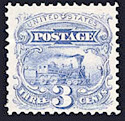Note from the Editor of the Chronicle: An article in Chronicle 211 (August, 2006) by Stephen B. Pacetti (SBP), discusses the color ultramarine and poses a question: What is true ultramarine for the 1861 1¢ Franklin, and does it actually exist as an issued stamp (Scott 63a)?
Pacetti also issues a challenge: Can anyone show an 1861 1¢ Franklin that matches the color of either of the two 1¢ Franklin essays known to have been printed in ultramarine, or the 3¢ 1869 (Scott 114), 6¢ 1869 (Scott 115) and 1¢ 1870 stamps (Scott 134 and 145), which were also printed in ultramarine? “Until then,” says author Pacetti, “in my opinion, the 1861 1¢ ultramarine does not exist.” Because illustrations in the Chronicle are currently confined to black and white, they can’t do full justice to Pacetti’s thesis. Thus, we’re taking advantage of the Society website to post here, as an added bonus, full-color images of the items that are illustrated in black and white, in Pacetti’s Chronicle article.
Technical Information (provided by SBP): The images were scanned at 300 dpi on an Epson Perfection U1200, using Photoshop CS2 on a Macintosh G4 and Apple LCD monitor. I used Photoshop to adjust the colors to match as best I could the true colors as seen by my eyes. I did not embed a color profile. I sharpened the images by 50%.
Keep in mind that the light source, color technology in different scanners, computers (PC vs. Mac), and monitors, not to mention the human eye, are important in understanding what you “see” when looking at a reproduced image.
Please feel free to E-mail Stephen with comments, questions, and/or to discuss your potential ultramarine examples.

(ultramarine)

(ultramarine)

(ultramarine)

(ultramarine)
At the Pigments through the Ages web site there is a separate section on ultramarine overview, history of use, making the pigment, and technical details. There are beautiful color examples and a well done discussion.

